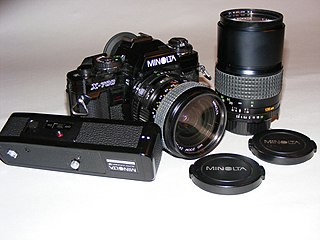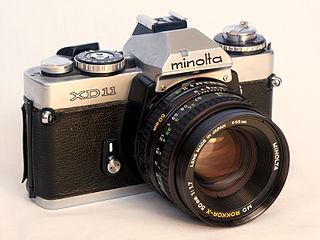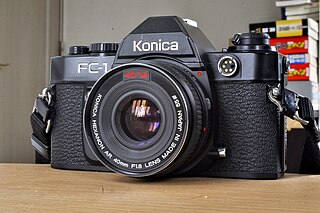
A single-lens reflex camera (SLR) is a camera that typically uses a mirror and prism system that permits the photographer to view through the lens and see exactly what will be captured. With twin lens reflex and rangefinder cameras, the viewed image could be significantly different from the final image. When the shutter button is pressed on most SLRs, the mirror flips out of the light path, allowing light to pass through to the light receptor and the image to be captured.
Konica was a Japanese manufacturer of, among other products, film, film cameras, camera accessories, photographic and photo-processing equipment, photocopiers, fax machines and laser printers. The company merged with Japanese peer Minolta in 2003, with the new company named Konica Minolta.

The Nikon F6 is a 35 mm film single-lens reflex camera body that became commercially available during 2004, and is the sixth top-of-the-line professional film camera in Nikon's line since the introduction of the Nikon F in 1959. The Nikon F6 is designed by Nikon and was manufactured at their Sendai Plant.

The Pentax Auto 110 and Pentax Auto 110 Super are single-lens reflex cameras made by Asahi Pentax that use Kodak's 110 film cartridge. The Auto 110 was introduced with three interchangeable lenses in 1978. Three more lenses were introduced in 1981, and then the Super model was released in 1982. The camera system was sold until 1985. The complete system is sometimes known as the Pentax System 10, apparently for its official Pentax name, although most Pentax advertising only uses the camera name or Pentax-110. This model represented the only complete ultraminiature SLR system manufactured for the 110 film format, although several fixed-lens 110 SLRs were sold. The camera system also claims to be the smallest interchangeable-lens SLR system ever created.

The Nikon FG is an interchangeable lens, 35 mm film, single-lens reflex (SLR) camera. It was manufactured by Nippon Kogaku K. K. in Japan from 1982 to 1986.

The Canon EF is a manual focus 35mm single-lens reflex camera produced by Canon between 1973 and 1978. It was compatible with Canon's FD-mount lenses. The EF was built as an electronic version of Canon's top-of-the line F-1 camera. Because of this, the EF shares the F-1's rugged construction and tough metal body. Unlike the F-1, the EF does not support any motor drive for film transport. Neither does it provide any interchangeable viewfinder.
The Olympus OM System was a line of 35mm single-lens reflex cameras, lenses and accessories sold by Olympus between 1972 and 2002. The system was introduced by Olympus in 1972. The range was designed by Yoshihisa Maitani, chief designer for Olympus, and his staff; OM stands for Olympus Maitani.

The Minolta XG-M was a 35mm single-lens reflex camera introduced in 1981 by Minolta of Japan. It was also known as the X-70 on the Japanese market, in which it was not available until 1982. When released, it was the top model in Minolta's XG series of consumer-grade manual focus SLRs, replacing the XG-9. Changes from that model included a metered manual mode, and a revised body style with rearranged controls. This was also the first camera to use Minolta's new logo, which was used until the 2003 merger into Konica Minolta.

Nikkormat was a brand of cameras produced by the Japanese optics company Nippon Kogaku K. K., as a consumer version of the professional Nikon brand. Nikkormat cameras, produced from 1965 until 1978, were simpler and more affordable than Nikon-branded cameras, but accepted the same lenses as the Nikon F series cameras.

The Minolta X-700 is a 35 mm single-lens reflex film camera introduced by Minolta in 1981. It was the top model of their final manual-focus SLR series before the introduction of the auto-focus Minolta Maxxum 7000.

The Pentax LX is a 35 mm single-lens reflex camera produced by Pentax in Japan. It was introduced in 1980 and produced until 2001. The LX uses the K mount which is the Pentax proprietary bayonet lens mount. It has manual and aperture priority automatic exposure modes. It is the top-of-the-line "professional" or "system" camera in the Pentax manual focus range, and has a large range of accessories. Compared with contemporary professional camera bodies from rival manufacturers, like the Canon New F-1 or Nikon F3, the LX body is smaller and lighter, weighing in at 570 grams with standard FA-1 finder.

The Konica FT-1 was the last SLR to be built both under the Konica name and by Konica themselves. The FT-1 was introduced in 1983 as an improvement on the earlier FS-1.

The Minolta XD-7 is a 35mm SLR film camera manufactured by Minolta from 1977 until 1984. It was Minolta's first SLR camera to feature both shutter priority and aperture priority automatic exposure modes. The camera also offered fully metered manual exposure as well as depth of field preview and an eyepiece shutter. Also, included were fully mechanical "O" and bulb settings, which allowed it to operate without a battery. The XD-7 was the top-of-the-line Minolta camera when it was in production and retains a reputation for quality. It was Minolta's last metal-bodied SLR design before the company switched to plastic with the X-700.
The Konica F was the first 35 mm SLR camera produced by Konishiroku, released in February 1960.

The Konica Hexar RF is a 35 mm rangefinder camera which was sold by Konica. It was introduced to the market on 13 October 1999. and subsequently discontinued some time before the end of 2003. The camera used the "Bayonet Konica KM-mount", a copy of the Leica M-mount, thus sharing interchangeable lenses with those designed for Leica cameras and others compatible with them. The Hexar RF has a combined rangefinder/viewfinder modeled on that of Leica cameras, a similar body shape and size - and so is similar to Leica M-mount cameras in many aspects of operation.

The Konica Hexar is a 35 mm fixed-lens, fixed focal length autofocus camera which was produced through the 1990s. It was introduced to the market in 1993. While styled like a rangefinder camera, and intended for a similar style of photography, in specification it is more like a larger "point and shoot" camera.

The Minolta CLE is a TTL-metering automatic exposure aperture-priority 35 mm rangefinder camera using Leica M lenses, introduced by Minolta in 1980.

The Minolta 9000 AF is a professional Single-lens reflex autofocus camera, introduced by Minolta in August 1985. It was both Minolta's and the world's first professional autofocus SLR. It was called Minolta Maxxum 9000 in the US and Minolta α-9000 in Japan.

The Auto-Reflex and Autoreflex is a series of 35mm SLR cameras made by Konica from 1965 to 1988. All these models have the Konica AR bayonet.

The Konica FC-1 was introduced in 1980 by Konica, one year after the FS-1, but does not have the integrated winder. It was manufactured until 1983. Both models were only available in a black finish. With top covers made from black plastic cast Konica had good experiences since the Autoreflex TC in the mid of the 70s.

















